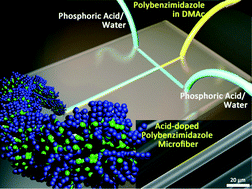A microfluidic approach to synthesizing high-performance microfibers with tunable anhydrous proton conductivity†
Abstract
Here, we demonstrate a new approach for the synthesis of ion exchange microfibers with finely tuned anhydrous conductivity. This work presents microfluidics as a system to control the size and phosphoric acid (PA) doping level of the polybenzimidazole (PBI) microfibers. It has been shown that the PA doping level can be controlled by varying the flow ratios in the microfluidic channel. The diameter of the microfibers increased with extending mixing time, whereas the doping level decreased with increasing flow ratio. The highest doping level, 16, was achieved at the flow ratio of 0.175. The anhydrous proton conductivity of the microfibers was found to be adjustable between 0.01 and 0.1 S cm−1 at 160 °C, which is considerably higher than for conventionally doped PBI cast membranes (0.004 S cm−1). Furthermore, molecular dynamic simulation of proton conduction through the microfibers at different doping levels was in good agreement with the experimental results. These results demonstrate the potential of the microfluidic technique to precisely tune the physicochemical properties of PBI microfibers for various electrochemical applications such as hydrogen sensors, fuel cells as well as artificial muscles.


 Please wait while we load your content...
Please wait while we load your content...